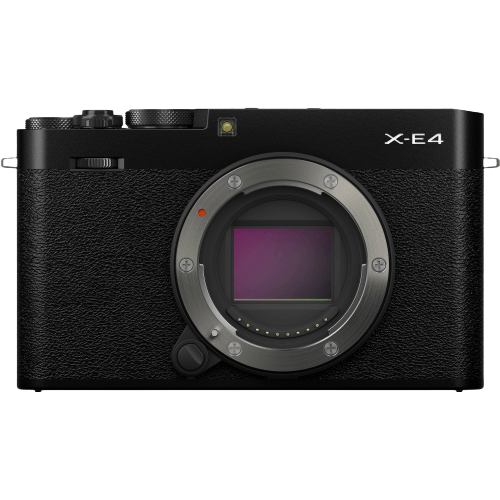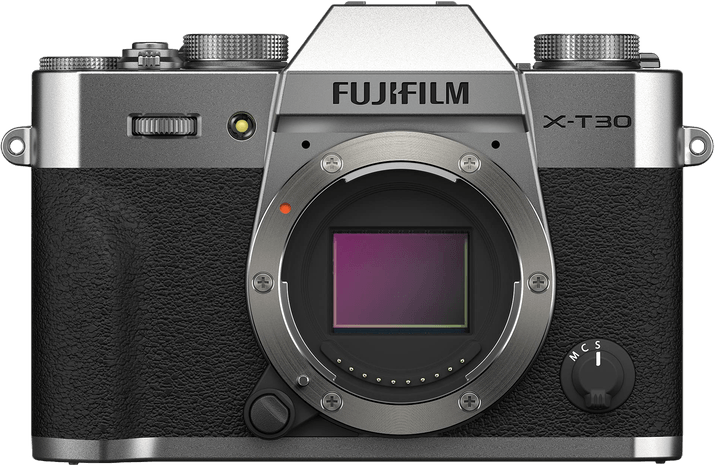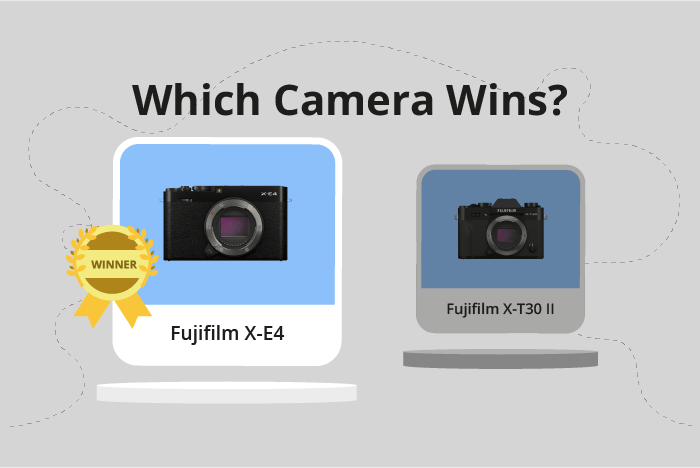Fujifilm X-E4 vs X-T30 II Comparison
Fujifilm X-E4

Fujifilm X-T30 II

The Fujifilm X-E4 edges out the Fujifilm X-T30 II with a score of 66/100 compared to 65/100. Both cameras are mirrorless, released in 2021, and share similar launch prices ($849 for the X-E4 and $899 for the X-T30 II). The X-E4 boasts a more compact size (121 x 73 x 33mm) and lighter weight (364g / 0.80lbs) than the X-T30 II (118 x 83 x 47mm, 383g / 0.84lbs), making it a more portable option.
On the other hand, the X-T30 II has a slightly larger body, which may provide better ergonomics for some users. However, the one-point difference in scores is minimal, and the choice between these two cameras ultimately depends on the user’s preference for size and weight. Both cameras offer excellent performance and features, so you can’t go wrong with either option.
Fujifilm X-E4 vs X-T30 II Overview and Optics
The Fujifilm X-E4 and Fujifilm X-T30 II both receive a score of 67/100 for optics, indicating that they have comparable optical performance. These two cameras share several key specifications, including 26-megapixel resolution, a CMOS sensor, the X-Processor 4, an APS-C sensor size, a Fujifilm X lens mount, and a lack of image stabilization.
The Fujifilm X-E4 has a shooting speed of 20 frames per second (fps), while the X-T30 II shoots at a faster 30 fps. This higher shooting speed in the X-T30 II allows for capturing quick action shots and rapid sequences, making it an ideal choice for sports and wildlife photography.
On the other hand, the Fujifilm X-E4, with its lower shooting speed, may be better suited for more casual photography or situations where the faster shooting speed is not essential. However, this does not necessarily make it a lesser camera, as it still offers excellent image quality and performance in most scenarios.
Both cameras have their strengths and weaknesses, with the Fujifilm X-T30 II offering a faster shooting speed, while the X-E4 might be more appropriate for those who do not require the higher speed. Ultimately, the choice between these two cameras will depend on individual preferences and the specific needs of a photographer. The equal score of 67/100 for both cameras’ optics reflects the fact that they both offer solid performance, and choosing one over the other will come down to the specific requirements of the user.
Fujifilm X-E4 vs X-T30 II Video Performance
The Fujifilm X-E4 and the Fujifilm X-T30 II both have a video score of 91/100, indicating that they are evenly matched in terms of video capabilities. They share several common features, such as 4K maximum video resolution and dimensions of 4096 x 2160. Additionally, both cameras have built-in time-lapse functionality, making them suitable for creative videography projects.
The Fujifilm X-E4 outperforms the X-T30 II in terms of maximum video frame rate, offering 240fps compared to the X-T30 II’s 120fps. This higher frame rate allows for smoother slow-motion footage, which is essential for capturing fast-moving subjects or adding a cinematic effect to videos.
On the other hand, the Fujifilm X-T30 II does not have any specific advantages over the X-E4 in video capabilities, as they both share the same video score and core features. The primary difference between the two cameras lies in the aforementioned maximum video frame rate.
Considering the video specifications of both cameras, the Fujifilm X-E4 is the better choice for videographers who prioritize slow-motion capabilities, thanks to its higher maximum video frame rate. However, for users who do not require such a high frame rate, the Fujifilm X-T30 II remains a solid option as it shares the same video capabilities as the X-E4 in all other aspects. Ultimately, both cameras offer impressive video performance and cater to different videography preferences.
Fujifilm X-E4 vs X-T30 II Features and Benefits
The Fujifilm X-E4 wins in the features category with a score of 72/100, while the Fujifilm X-T30 II scores slightly lower at 70/100. Both cameras share several specifications: they have 3-inch screens, touchscreens, flip screens, no GPS, and support for both WIFI and Bluetooth.
The X-E4 is superior due to its higher screen resolution of 1,620,000 dots compared to the X-T30 II’s 1,040,000 dots. This higher resolution provides a clearer and more detailed display, which is essential for photographers to accurately review and compose their shots.
The X-T30 II has no unique advantages over the X-E4 in terms of features. Both cameras are evenly matched in their other specifications, making the X-E4 the better choice for those who prioritize features in their camera selection.
In comparing the Fujifilm X-E4 and X-T30 II, the X-E4 comes out ahead with a higher features score and superior screen resolution. The X-T30 II does not have any specific advantages over the X-E4 in this category. Therefore, photographers who value features in their camera should opt for the Fujifilm X-E4, as it provides a better overall experience with its higher-resolution screen.
Fujifilm X-E4 vs X-T30 II Storage and Battery
Both the Fujifilm X-E4 and the Fujifilm X-T30 II have the same storage and battery score of 35/100. They share identical specifications in this area, making it a tie in terms of storage and battery performance.
The Fujifilm X-E4 and X-T30 II each have one memory card slot, accepting SD, SDHC, and SDXC cards (UHS-I compatible). This provides equal storage capacity and compatibility for users of both cameras. Battery life is also on par between the two models, with both offering 380 shots per charge. They use the same NP-W126S battery type and support USB charging.
Neither camera outperforms the other in terms of storage and battery. This makes the choice between the Fujifilm X-E4 and X-T30 II dependent on other factors, such as design, features, and personal preference. Both cameras offer reliable storage and battery performance, ensuring that users can capture and store their photos and videos effectively.
Fujifilm X-E4 vs X-T30 II – Our Verdict
Are you still undecided about which camera is right for you? Have a look at these popular comparisons that feature the Fujifilm X-E4 or the Fujifilm X-T30 II:

